Bicycle ridership across New York City’s East River bridges has reached unprecedented levels for the fourth consecutive year, the New York City Department of Transportation (DOT) announced in a press release.
From April to October 2024, an average of 28,108 cyclists crossed the Brooklyn, Manhattan, Williamsburg, and Ed Koch Queensboro Bridges daily, marking an 8.4% increase from last year and and a 17-fold jump since the city began tracking bike traffic in 1980.
“More and more New Yorkers are opting to get around by bike because it’s a fast, convenient, and safe way to travel around the city," said DOT Commissioner Ydanis Rodriguez. "Another year of record-breaking ridership over our four iconic East River bridges illustrates how NYC DOT’s efforts to build safe cycling spaces has spurred tremendous growth."
The Brooklyn Bridge saw the steepest increase in ridership, with daily averages rising 15.4% from 2023 to 5,504. The Williamsburg Bridge remained the busiest, serving 8,645 riders daily, an 11% increase. September 2024 marked a milestone, with daily crossings surpassing 30,000 for the first time.

Citywide, midtown Manhattan also saw record levels, with more than 43,800 cycling trips recorded on average during a 12-hour window along 50th Street—a 12.5% increase over last year.
The ridership surge coincides with extensive DOT efforts to enhance cycling infrastructure. In 2023, the agency installed a record number of protected bike lanes, a trend continuing in 2024 with projects like:
- Brooklyn Bridge: New protected bike lanes on Centre and Lafayette streets in Manhattan.
- Williamsburg Bridge: A bike boulevard on Berry Street in Brooklyn.
- Manhattan Bridge: A protected lane on Navy Street and Ashland Place in Brooklyn.
- Queensboro Bridge: A completed bike lane network in Long Island City, Queens.
Additionally, DOT widened bike lane segments on Manhattan’s Second Avenue and introduced a two-way bike path over the Washington Bridge, connecting upper Manhattan and the Bronx.
For 2025, DOT plans significant upgrades, including doubling cycling and pedestrian space on the Queensboro Bridge and launching bike-friendly improvements along Delancey Street to enhance access to the Williamsburg Bridge.




